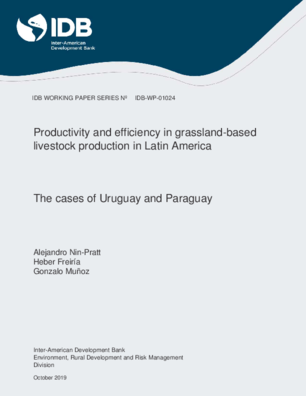Productivity and Efficiency in Grassland-based Livestock Production in Latin America: The Cases of Uruguay and Paraguay
Date
Dec 2019
This study looks at the performance of livestock production in Uruguay and Paraguay, analyzing two situations with different implications for development: the displacement of livestock by soybean production as occurred in Uruguay and in the Eastern region of Paraguay, and the expansion of the agricultural frontier in western Paraguay through deforestation. In the case of Uruguay, and despite being displaced to lower-quality land, the livestock sector has seen a historical increase in output and productivity between 2002 and 2006 as the result of rapid growth in beef and milk production and a reduction of sheep stocks to historical lows. This growth was driven by changes in nutrition, mostly due to an increase in the area under cultivated pasture during the second half of the 1990s, the use of grain and supplements associated to dairy production, and more recently, by intensive fattening of cattle. Improved nutrition resulted in a reduction in the slaughter age of steers, an increase in the offtake rate and a larger contribution of dairy to total output. In the case of Paraguay, beef production more than doubled between 2005 and 2016, driven by productivity growth which increased by 70 percent during this period. The expansion of soybean production in the Eastern region after 2006 displaced livestock to the Western Region of Chaco. In this new environment, the adoption of high yielding varieties of tropical pastures together with improved animal genetics were the main factors behind increased productivity. Despite these positive developments, livestock sectors in Uruguay and Paraguay still face major challenges to sustain growth in the future. In the case of Uruguay, the challenge is to accelerate and sustain TFP growth, which stagnated again after 2006. For Paraguay, challenges for future development are those related to the environment, as future expansion of production will continue to take place into forest land in the Chaco region. Although the introduction of cultivated pastures has increased productivity and reduced emissions per unit of output both in Uruguay and Paraguay, in the case of Paraguay, increased production, a growing animal stock and deforestation will continue to increase GHG emissions and will require greater control in the use of natural resources and new technological developments to increase environmental efficiency of livestock production.




